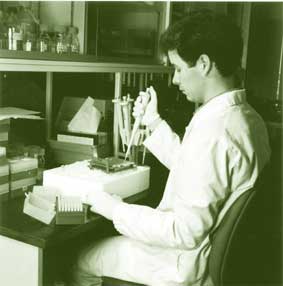
DNA: A print to Identify Pests
Increased trade, transport, tourism and climate
change result in the introduction into Canada of exotic pests that
threaten the balance of forest ecosystems. To detect these pests before
they become established and to prevent their spread, researchers at
the Canadian Forest Service, in collaboration with Genevision Inc.
(Warnex Inc.), have developed a simple diagnostic method based on
the presence of the DNA of pests on the host plant.
The first kit is being marketed (2002) under the name
SCLEROTEST™; it helps detect Gremmeniella abietina,
the fungus that causes scleroderris canker. This simple technique
involves the extraction and amplification of DNA from coniferous
seedlings and the use of specific fluorescent probes, or “molecular
beacons”, that emit a light signal only when a targeted DNA,
such as that of G. abietina for example, is present. The light signal
is then detected by a photoelectric receptor.

Preparing a mixture for DNA amplification.
Photo: C. Moffet
|
The advantages of this biotechnology are numerous:
it requires little infrastructure and it can be carried out rapidly
by staff trained in molecular biology, compared with traditional
methods that could take weeks or months and that require extended
knowledge of taxonomy. In fact, in only six hours, the analysis
not only shows whether the pathogen is present in the seedling,
but it also helps determine whether it is from the American (indigenous)
or European (exotic) strain. Importers, exporters, nursery farmers
and anyone responsible for ensuring the safety of seedlings or plants
can now benefit from this advanced tool.

Mixture for DNA extraction.
Photo: C. Moffet
|
All living organisms have DNA: it is the basis
for molecular diagnostics methods. When a DNA segment specific to
a given pest causes light to be emitted from the molecular beacons,
other diseases and threatening insects can easily be detected and
their spread prevented or slowed down. In response to, among other
things, the urgent needs of the Canadian Food Inspection Agency
(CFIA), which is responsible for plant protection at borders, researchers
are currently working on developing quick-diagnostic kits for white
pine blister rust, Sudden Oak Death, and brown spruce longhorn beetle.
Some new miniaturization technologies could
help detect several pests in one sample directly on site. This tool
would be very useful for forest tree producers to quickly detect
affected lots before using them and thus avoid spreading diseases
and insects on a large scale.
Researchers at the Canadian Forest Service, in collaboration
with Genevision (Warnex), the ministère des Ressources naturelles,
de la Faune et des Parcs du Québec, Agriculture and Agri-Food
Canada’s Biosystematics Research Institute, and the Canadian
Food Inspection Agency worked on developing the molecular diagnostic
kits.

Reading DNA gel.
Photo: C. Moffet
|
Warnex inc.: www.warnex.ca
For further information, please contact:
Richard Hamelin
Natural Resources Canada, Canadian Forest Service
Laurentian Forestry Centre
1055 du P.E.P.S., P.O. Box 3800, Sainte-Foy, Quebec G1V 4C7
Phone: (418) 648-3693 • Fax: (418) 648-5849
E-mail:
Web site: www.cfl.cfs.nrcan.gc.ca
|
© Her Majesty the Queen in Right of Canada 2003
Catalogue Number Fo29-54/2-2003E
ISBN 0-662-33948-7
ISSN 1705-578
|